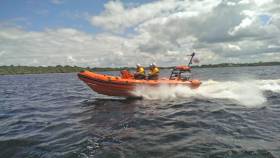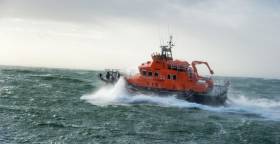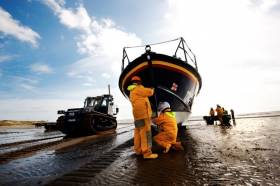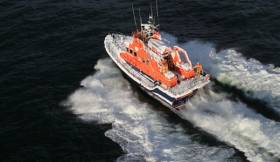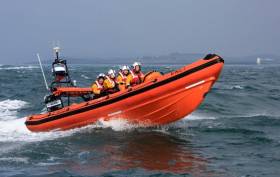Displaying items by tag: Lifeboats
Two Callouts In 24 Hours For Lough Ree Lifeboat
#RNLI - The volunteer lifeboat crew with Lough Ree RNLI were called out twice in 24 hours to assist grounded vessels in the Wood Shoal area.
Thankfully there were no injuries any of those on board across both vessels, but the RNLI has advised marine users in the area to use caution and heed advice around submerged rocks.
The first callout came after midday on Tuesday (29 March) to reports of a cruiser with 10 people onboard grounded at Mouse Ear Rock.
When on scene, a lifeboat crew member boarded the vessel and assessed it for damage. There was a strong vibration from the engine and it was suspected that there may be damage to the propeller.
The lifeboat crew took the vessel under tow to Portrunney were it could be checked over for damage. The lifeboat was back on service shortly after 2pm with everyone safely ashore.
The second callout came the next day (Wednesday 30 March) at 3.35pm and was again to a grounded vessel, this time at Iskeraulin Shoal, south of Quaker. There were six people onboard with no reports of injuries.
On arriving on scene at 4.06pm, the lifeboat crew again assessed if there was any damage to the cruiser.
When it was confirmed that everything was working they helped the vessel free of the rocks and monitored its progress by travelling alongside it for a time. Once satisfied there was no further difficultym they departed the scene and returned to the station.
Commenting on the callouts, Lough Ree RNLI lifeboat operations manager Damien Delaney said: "Our volunteer lifeboat crew had a busy 24 hours. We would urge everyone using Lough Ree to ensure they are familiar with the area and to take heed of any warnings for rocks.
"Grounded vessels are not unusual but with any callout there are a number of factors that should be considered, such as weather and the right equipment. Make sure you have a suitable means of calling for help and that you have the proper clothing and a lifejacket. You never know when you will need to call for help."
Lough Ree was among the busiest of Ireland's lifeboat stations in 2015, recording the highest number of people assisted, as previously reported on Afloat.ie.
Bangor Lifeboat Aids Fishermen After Engine Failure
#RNLI - Bangor RNLI’s volunteer lifeboat crew were requested by Belfast Coastguard to help two fishermen on a 17ft motorboat with engine failure.
Although conditions were calm and the crew were in no immediate danger, the westerly wind was extremely cold and blowing the fishing boat offshore.
The call to lifeboat operations manager Kevin Byers came in at 5.06pm yesterday evening (29 March) and the lifeboat launched at 5.15pm.
The lifeboat made its way to the reported position to the south of the Gobbins outside Belfast Lough, only to find the boat wasn’t there, and they were only able to locate it by radioing the boat for a position update.
On arrival, the volunteer lifeboat crew made sure the boat and crew were sound, and towed the boat to Carrickfergus Harbour, where they were thanked by an extremely grateful skipper.
Helming Tabby Cat, the temporary replacement for Bangor's regular lifeboat Jessie Hillyard, Bangor RNLI crewmember Gareth Whan said: “An incident like this emphasises the importance of good engine maintenance, particularly as many boats have been unused over the winter months.
“It also demonstrates the importance of warm clothing, as the crew of the rescued boat were extremely cold by the time we reached them – it is always much cooler on the water than it is on dry land.”
#RNLI - Rosslare Harbour RNLI's volunteer crew launched their all-weather lifeboat at 2am this morning (Wednesday 30 March) on request by the Irish Coast Guard to attend an injured man who was working on the Tuskar Rock lighthouse.
Once on scene, 8km from Rosslare Harbour, the all-weather lifeboat deployed its Y-class rescue boat to reach the landing area on the rock, but due to a heavy swell a landing was not possible.
Lifeboat operations manager David Maloney had anticipated that scenario and had already requested the coastguard helicopter Rescue 117 from Waterford.
The helicopter was quickly on scene and lifted the injured man aboard, flying him to Waterford Airport where an ambulance was waiting to transfer him to hospital.
Apart from a heavy swell, weather conditions at the time were calm with a clear dry night. The lifeboat remained in the area until the airlift was completed and then returned to base at Rosslare Europort.
Commenting after the event, Maloney said: "The lifeboat crew were quite correct in not attempting to land on the rock due to a heavy Atlantic swell. We wish the man a full recovery."
#RNLI - Clogherhead RNLI's volunteer lifeboat crew launched their all-weather lifeboat at 11:50am yesterday (Sunday 20 March) in response to a distress EPIRB signal received from a fishing vessel located 25 miles east of Clogherhead.
While en route to the location of the signal, the Clogherhead crew was informed that the Irish Coast Guard helicopter Rescue 116 had winched the three people from a liferaft and were proceeding to hospital.
The lifeboat continued on to the signal's location in good weather and calm seas, arriving at the scene at 1:38pm. The liferaft was located and recovered and the EPIRB was found nearby a short time later.
Sun Shines On St Patrick's Day Donation To Clifden Lifeboat
#RNLI - Bright sunshine and a much appreciated donation was a great start to St Patrick’s Day for the crew of Clifden RNLI.
Longtime supporters and fundraisers Jacqueline Hannon and Nancy Duffy of Claddaghduff, Co Galway presented a cheque for €1,820 to the Clifden volunteer lifeboat crew, the proceeds of a Christmas concert and fundraising event held in Joyce’s Bar in the fishing village of Cleggan on 16 December.
John Brittain, Clifden RNLI Lifeboat Operations Manager said: "We are really delighted to welcome Jacqueline and Nancy to Clifden station once again and would like to thank them most sincerely for the hard work and organisation of this fantastic fundraiser.
"Special thanks also to the people of Cleggan and Claddaghduff who generously supported the event."
After the cheque presentation, the volunteer crew participated in both the Clifden and Roundstone annual St Patrick’s Day parades.
#RNLI - Portrush RNLI had a busy 24 hours earlier this week with two early morning callouts on consecutive days.
The volunteer lifeboat crew was alerted at 4.45am on Monday (14 March) to reports of a fishing vessel that had lost power two miles off the coast of Ballycastle.
However, as the all-weather lifeboat approached Ballycastle the crew was stood down as another vessel had responded and assisted the vessel to get underway.
The crew was requested to launch once again went at 12.30am yesterday morning (Tuesday 15 March) to reports of a 23m fishing vessel 12 miles northwest of Portrush that had got nets caught around its propeller.
The weather was cold but calm and the Portrush lifeboat crew were joined by their lifeboat colleagues from Lough Swilly RNLI and their new Shannon class lifeboat, The Derek Bullivant.
The Portrush crew attached a towline to the fishing vessel and towed her into Greencastle Harbour under the guidance of Lough Swilly RNLI
The Portrush crew had last seen the Shannon when she and her crew made Portrush their last call when returning from Poole to Buncrana in April last year.
Speaking following the callout, Portrush RNLI lifeboat operations manager Robin Cardwell said: "This was a tow for which both crews are trained and executed perfectly.
"The Portrush crew towed the vessel into Greencastle and aworked well with our flank station Lough Swilly who helped us into harbour."
Fun & Fitness At Lough Ree RNLI Charity Cycle
#RNLI - Lough Ree RNLI’s third annual Lap Of Lough Ree charity cycle took place on Sunday 6 March, with 88 cyclists setting off in cold, dry weather at 10am.
The cycle started and finished at The Bounty, Buccaneers Rugby Club in Athlone and travelled north through Ballymahon, crossing the Shannon at Lanesborough, where refreshments were available courtesy of the Radisson Blu Hotel.
Cyclists then completed the 85km lap of Lough Ree in somewhat wetter conditions, travelling south on the Roscommon side, via Kilteevan, crossing the Shannon again at Athlone Bridge and returning to The Bounty for the finish.
Hot drinks were available at The Bounty for the returning cyclists, who reported that the going was a little slow for the first section but picked up pace nicely from Lanesborough.
Many of the attending cyclists are members of cycling clubs, and enjoy this event as a warm-up for the upcoming competitive cycling season.
Lough Ree RNLI treasurer Vincent Rafter said: "The cycle was a great success again this year and is becoming a firm fixture on the cycling calendar, as well as drawing casual cyclists from the area. There is a nice camaraderie among participants of all ability, and good fun was had along the way."
In other news, Lough Ree RNLI is currently seeking volunteers to join the lifeboat crew and shore crew.
This is a great opportunity to make a difference in your community, meet new people and use your skills to support the RNLI.
Boating experience and knowledge of Lough Ree are preferred but not essential. All training and kit is provided.
If you are interested and have the time to commit to this role, please contact Lough Ree RNLI lifeboat operations manager Damien Delaney at 087 2437092 for further information. The closing date for expression of interest is Monday 21 March.
Kilkeel Lifeboat Aids Fishing Vessel Rapidly Taking On Water
#RNLI - Kilkeel RNLI's volunteer lifeboat crew launched at 9.20am yesterday morning (Monday 14 March) to go the aid of a fishing vessel rapidly taking in water about 25 miles southeast of Kilkeel, Co Down.
The vessel was in a heavy swell when water was seen in the fish room. The boat’s pump was unable to cope with the water entering and at one stage the fish room was three-quarters full of water. It had begun to affect the stability of the boat when the alarm was raised and help was dispatched.
When Kilkeel RNLI arrived on scene, the lifeboat was carefully manoeuvred by its volunteer crew alongside the vessel in an increasingly heavy swell, and two of the lifeboat crew went aboard the fishing vessel with a salvage pump. Newcastle RNLI’s all-weather lifeboat was also on scene to render assistance.
The Kilkeel lifeboat then transferred a further pump from the Newcastle lifeboat, and with all the pumps working the boat was kept afloat. The two lifeboats then escorted the fishing boat under her own steam safely into Kilkeel Harbour, arriving at about 12.45pm.
John Fisher, Kilkeel RNLI lifeboat operations manager, said: "If the incident had happened further out to sea then the operation would have been more difficult, but with the Kilkeel and Newcastle lifeboats co-operating well together, the fishing boat and its crew were brought safely ashore.
Kilkeel RNLI's volunteer lifeboat crew on this callout were Raymond Newell, Alan Henning, Andrew McConnell and Wayne Marshall.
#RNLI - The volunteer lifeboat crew at Portaferry RNLI launched yesterday afternoon (Tuesday 8 March) to the aid of two kayakers stranded on an island in Strangford Lough.
The two men were on a camping trip to Boretree Island, just off the coast at Mount Stewart, and had paddled out to set up their tent.
When they returned to where they had landed their kayak, they found that it had drifted off in the tide.
Waving a flag to attract attention, the two men were spotted by walkers on the mainland shore who contacted the coastguard, who subsequently requested Portaferry RNLI to launch to rescue the campers.
Weather conditions at the time were good, slightly cloudy with a slight Force 3 wind. Visibility was good and sea conditions were also fairly calm.
The volunteer crew of the Portaferry lifeboat, an inshore Atlantic 85, launched at 12.40pm and were quickly on scene, where they transferred the two men into the lifeboat. They were then taken safely to shore at Newtownards Sailing Club.
Brian Bailie, lifeboat operations manager for Portaferry RNLI, said: "We are delighted to once again have been able to provide assistance to members of the public who found themselves in trouble at sea.
"With its fast flowing currents and tides, Strangford Lough can at times catch out even the most experienced. The lough has for a long time and will for the foreseeable future be a real draw for water enthusiasts and we at Portaferry RNLI are always ready to provide assistance when required."
Donaghadee Lifeboat Volunteers Are Ready For Action
#RNLI - On Sunday 6 March 2016, Donaghadee RNLI coxswain Philip McNamara and the volunteer lifeboat crew mustered for the latest in a series of vital fortnightly sea training exercises to ensure they are prepared for the challenges of the year ahead.
The Trent Class lifeboat Saxon was also hauled up a slipway in Carrickfergus last week to have its hull power-washed and a fresh coat of antifouling paint applied. The task is undertaken every six months to ensure the £2 million vessel is always at peak performance and can reach the scene of an emergency at 25 knots.
Last year Donaghadee’s RNLI volunteers responded to 23 calls for help starting in January when they battled "atrocious" seas to bring an injured workman from the Copeland Islands where he has working on the lighthouse.
The lifeboat crew rescued stranded kayakers and their dogs. They came to the rescue of a member of the crew on a cross channel ferry who had taken seriously ill during a night crossing.
“It has been a relatively quiet winter for us but the number of rescue requests usually picks up around Easter and reaches a peak in summer," said McNamara.
"The crew is ready and the lifeboat is ready too. Every time we put to sea volunteers risk their lives to save others but we are trained and experienced, to deal with emergencies and are part of a dedicated team which includes the Coastguard, Police Service of Northern Ireland, Northern Ireland Fire and Rescue Service and Air Sea Rescue.”
The Donaghadee crew is at full strength, but lifeboat operations manager Peter Irwin says there is still room for more.
“We would like two more trainees to join us and I would be happy to hear from suitable people in the town who feel they can give their time to the charity that saves lives at sea.”




























